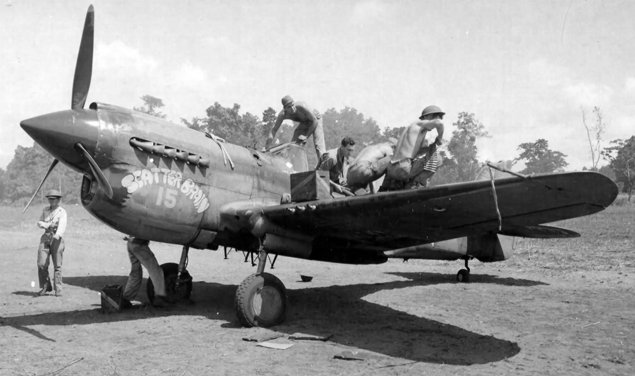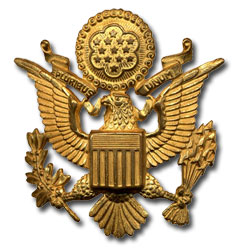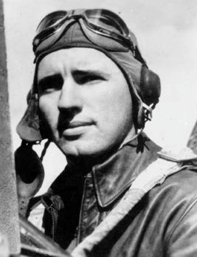Eisenhower Presidential Museum Archives - World War II Leaders, Battles & Heroes Remembered
49th Fighter Group - Pacific Theater
At the time he was commissioned into the Air Corps of the Army of the United States, March 14, 1941, Second Lieutenant Sonny Johnson cut a dashing figure, seated in the cockpit of his BT-14. At age 21, Sonny was a ruggedly handsome, newly minted, second lieutenant, with blue-grey eyes and wavy light-brown hair. His parents must have been incredibly proud of their only child. He had graduated from high school with honors, earned a degree in aeronautical engineering, and had graduated in the upper echelon of his flying cadet class. An exceptionally gifted—and naturally competitive—new fighter pilot, Sonny intended to become the best of the best.
Charles Cousins Johnson, III, was born in Fort Worth, Texas, August 2, 1919, to Charles, Jr., "Charlie," and Hattie Mae Johnson. He grew up in a “cozy bungalow” at 4025 Bryce Ave., in the Arlington Heights neighborhood. There his boyhood years were filled with swimming, ice-skating, archery, and target practice. But, most of all, he loved building model airplanes. In 1936, Sonny graduated from W.C. Stripling High School, just days after his 17th birthday. As “Class Representative,” he delivered an address entitled, "Our Schools of Today." Ranked first among senior honor students, he was awarded a scholarship to Texas Christian University. In 1938, he transferred to North Texas Agricultural College (NTAC), graduating in 1940. In the summers, he worked as a motion-picture projectionist and an advertising assistant—his father’s profession.
In the spring of 1939, Sonny was one of 30 college students selected for the Civil Aeronautics Authority’s "Youth-in-Aviation" program. The following summer (1940), he was one of only seven chosen for the CAA’s advanced flight training. That September, he enlisted in the Army Air Corps’ “Flying Cadet” program, graduating in March 1941, commissioned a second lieutenant. His father had been an “officer” pilot and an Army Air Corps instructor at Kelly Field during the Great War.

1st Lt. Charles C. Johnson, III flew a Curtiss P-40E Warhawk similar to one pictured above. On 23 August 1942 he led a flight of P-40s, which intercepted a large formation of Japanese bombers and fighter over the Timor Sea, northwest of Australia. (National Archives)
Following graduation, Sonny was assigned to the 49th Pursuit Group. Just weeks after Pearl Harbor, the 49th was mobilized, boarding the USAAT Mariposa on January 14, 1942, bound for Melbourne, Australia. (The 49th Fighter Group eventually amassed an unmatched record of 668 aerial victories in the Pacific Theater in WW II.) By mid-April, the unit was deployed to the Darwin area to prevent a threatened Japanese invasion. On April 27, Sonny’s squadron was among those that intercepted, and turned back, an estimated 14-20 bombers and a fighter escort of 12 Zeros.
By mid-June, he had been in Australia for four months and was now a “flight leader” and engineering officer. Earlier that month, Sonny was promoted to first lieutenant and, on June 13, he was wounded in aerial combat, sustaining “severe” shrapnel wounds in his left arm and shoulder. With one functioning arm, and bleeding profusely, Sonny managed to land—and save—his Curtiss P-40E “Warhawk.” Following a hospital stay and convalescence, he was anxious to return to combat. On June 20, he was awarded the Purple Heart.
By the first week of July 1942, Sonny had resumed his duties. Engaged in combat over the Timor Sea on August 23, he led a flight group of P-40s, which intercepted a large formation of Japanese bombers and fighters. Downing a Zero and damaging several others, Sonny was awarded the Silver Star for “gallantry in action.” Shortly thereafter, he was promoted to captain. In early October, the headquarters of the 49th Fighter Group moved to Port Moresby, New Guinea. Here Sonny was wounded a second time in the defense of Port Moresby and was transferred to Hamilton Field Hospital, near San Francisco, in early November.
354th Fighter Group
In mid-November 1942, at Hamilton Field, the 356th Fighter Squadron was created as a new unit of the 354th Fighter Group. Sonny was appointed Commanding Office, charged with building and training the new squadron. Back home in Fort Worth, he had time to visit his doting—and much relieved—parents and his maternal grandparents, who lived in San Antonio. "Captain Johnson," war hero and celebrity, delivered a number of talks to groups in both cities. One Fort Worth Press article, dated November 14, reported that when the young captain was asked how duck hunting compared to hunting Zeros, he had replied, "When you’re aiming at ducks ahead of you, you don’t have to turn around and look for ducks behind you."

Capt. Johnson was killed during a training flight in a Bell P-39L Airacobra like the one pictured here. The P-39L had an improved V-1710-63 engine fitted with the Curtiss Electric propeller with a diameter of 10 feet 4 inches. A total of 250 were built under the designation of P-39L-1. (National Archives)
On December 20, Sonny was deemed qualified for “duty involving flight,” although he was back in the hospital by early January for observation and more tests, and was finally transferred to San Francisco’s Letterman General. Still there was no diagnosis. In the meantime, the new 356th squadron was sent on to the bombing and gunnery range at Tonopah, Nevada; Sonny would join them later that month. On February 6, 1943, Sonny climbed into the cockpit, as he had hundreds of times before, for a routine training flight in a new P-39L Airacobra. For reasons unknown, his airplane crashed to the ground—the first tragedy for the new squadron. World War II decorated fighter pilot, Captain Charles C. Johnson, III, died instantly.
356th Fighter Squadron Historical Record
On February 6th, the daily report of the Operations Officer reads "Excellent flying weather". Early that morning Captain Johnson, the Commanding Officer of the Squadron, cleared the field for one hour of transition flying. At 0910 his plane crashed eight miles east of the Tonopah Bombing Range. The accident was entered in the records with the brief conclusion, "Cause of accident unknown". His death came as a severe blow to the officers and men alike. He had possessed the essential attributes of leadership that go to make up a Commanding Officer: quiet and unassuming, yet precise and efficient in his commands and administration. He gave no orders merely for the purpose of showing his authority, and he could never be accused of "pulling his rank" on the men under him. The things he wished done were accomplished not so much because of the bars on his shoulders, but because his decision was inevitably the logical and best under the circumstance. He was respected and admired primarily as a man, secondarily as the Commanding Officer. In the words of one of the pilots "he was a man's man, and more, a pilot's man".
Offical entry in the 354th Fighter Group Historical Records:
Captain Charles C. Johnson, III, AC, Commanding Officer of 356th Fighter Squadron, accidentally killed in crash of airplane P-39L *(42-4488) on February 6, 1943. Major Wallace W. Mace, Group Executive Officer, assumed temporary command of the 356th Fighter Squadron, February 6, 1943. Vice Captain Charles C. Johnson, III, Deceased.
*Official records list the crashed P-39L with serial number 42-4488. However, research indicates it to be serial number 42-4468. Source: Aviation Archaeological Investigation & Research.
The P-39 Problem: Excerpt from Target Luftwaffe, By William Ong
While ever effort has therefore been made to assure factual accuracy, Target Luftwaffe should nevertheless be considered as a biographical novel rather than a purely historical chronicle. The author has obviously taken certain liberties in recounting direct conversations held 35 to 40 years earlier and in adding details of negligible factual significance which are nevertheless vital in capturing for the reader the aura and spirit of those troubled but victorious times. For the use of such techniques, the indulgence of both the subject and the reader is requested.
Many of the pilots reporting at Tonopah had no other flying time or experience beyond that acquired in flight training. They had flown nothing more sophisticated than the advanced trainer, the North American AT-6. The conventional design and the dependable 600 horsepower Wasp engine combined to make the AT-6 an "honest" airplane, in pilot's parlance a category reserved for those airplanes "free from original sin."
The Bell P-39 was a lot of airplane for many of the pilots reporting directly from an advanced flying school. It was powered with the Allison engine, developing about 1,200 horsepower, installed behind the pilot's cockpit. The low wing was eight feet shorter than the AT-6 and the wing loading correspondingly higher. The aft position of the engine produced a critical rearward C.G. (center of gravity). The gross weight of the P-39 was 6,600 pounds-2,300 more than the AT-6. The high wing loading produced faster stalling speeds, a situation that developed an accident ratio much too high. Martin was worried.
The basic problem was the spin characteristics of the P-39. When the airplane stalled and spun, severe backpressure developed and the spin tended to be flat. Recovery could be made only by first getting the nose down, after which normal spin recovery was effective.
Although the new pilots had spun the AT-6, an airplane that required sharp and positive forward-stick in recovery, they did not realize the amount of pressure required by the P-39. This was the cause of most of the accidents at Tonopah.
Captain Johnson talked with Martin about the situation.
"What we need is some kind of a standard recovery procedure we can teach our new pilots. Right now, we have more or less our own way of handling the P-39 in a spin. These new men don't have the hours or the experience to help them. What do you think about it? I'd like to take a ship and go upstairs and stay until I've worked out an effective procedure we can adopt as standard."
"We've got to do something, and quick," Martin said. "If you think you can find a solution, go ahead. But be careful-don't get in too deep at first and stay high." "Fine. I'll get started today. And don't worry!" It was 6 February, a clear, cold day. That afternoon Captain Charles C. Johnson was killed. His P-39 had not recovered from the last of a series of spins he had executed.
Captain Richard D. Neece took over the 356th Squadron. The loss of Johnson not only was a blow to the Group, but also it affected Martin deeply. He had regarded the Captain as not only a fine officer but a close friend.
The P-39 problem still remained. Martin intended to pursue Johnson's investigations personally. An effective spin recovery procedure must be found-quickly. Martin used a new P-39 for his tests. On his first flight he intended to go to 20,000 feet for his initial experiments. At 8,000 feet he began to use oxygen; a little early but insurance that his faculties would be at maximum alertness.
At 15,000 feet he had difficulty breathing. He was puzzled, for many times pilots would fly briefly as high as 18,000 feet without oxygen. Vaguely, unable to concentrate, he tried to check the oxygen system. The P-39, climbing at full throttle, had just left 19,000 feet when he lost consciousness.
A blast of air on his face was his first realization that he had been out. A side glass in the windshield had blown in and air was rushing into the cockpit. His mind and vision cleared in the clean, cold blast.
The throttle was closed. The altimeter indicated about 5,000 feet above the desert. The ship was in a slow, flat spin to the right. Martin, using both hands on the stick, shoved it full forward and kicked full opposite rudder. Slowly the P-39 responded. He still had 2,000 feet of altitude when full recovery was effected.
On the ground investigation revealed that the oxygen tank had contained nitrogen, the gas initially used to check the system for leaks. It was supposed to be cleared from the lines and replaced with oxygen after the test. Someone had forgotten.
The P-39, climbing at open throttle, had dived when Martin lost his senses and slumped forward. The high speed had blown out the side of the windshield and let in the fresh air that partially revived him. He must have closed the throttle again, and the ship, after a series of oscillations, had stalled and spun. It had been a close thing.
Eventually, he evolved a procedure for spin recovery in which all new pilots were thoroughly briefed. The accident ratio decreased sharply.



